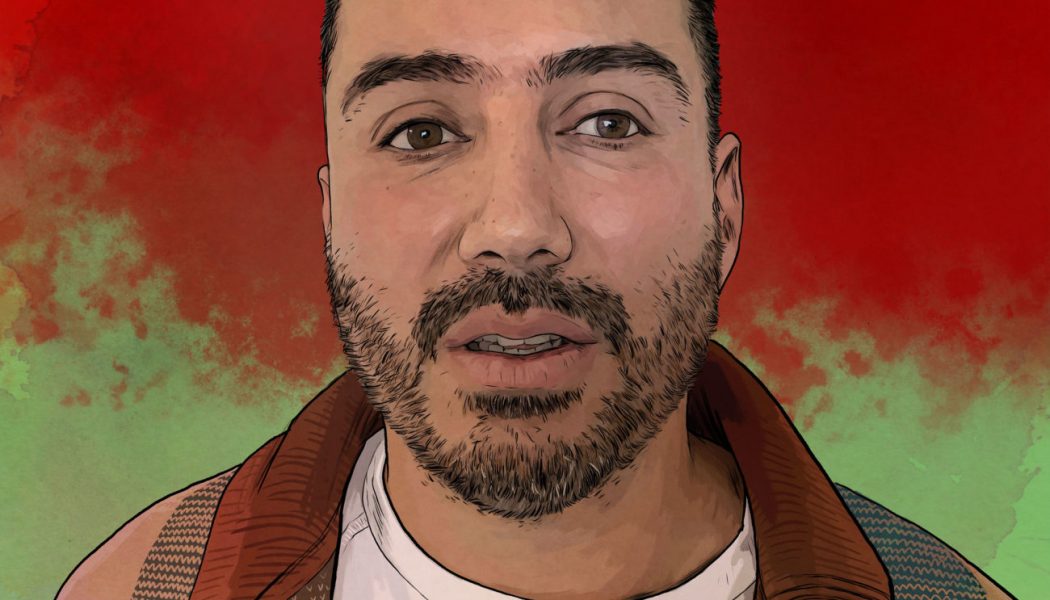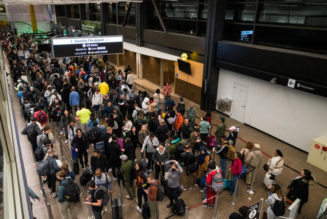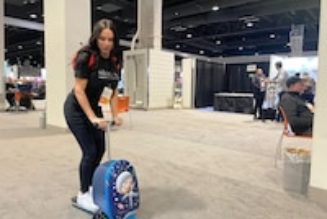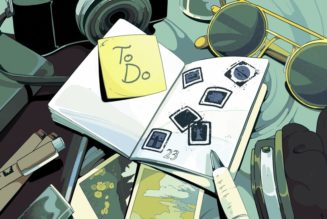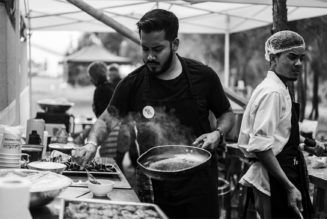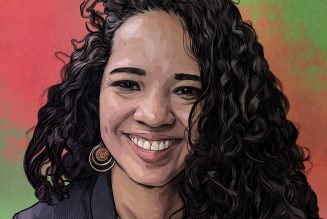
This week on The Trip podcast: Tijuana design legend Edoardo Chavarin on growing up with one foot on each side of the border wall, how to brand Mexico, and why Tijuana is having a creative revolution.
It is deceptively simple. Exchange your dollars, walk a couple hundred yards, get your passport stamped, keep walking, wave off the taxistas and hustlers, sit on a plastic chair and order an al pastor torta, a sandwich so heavy with meat and mayonnaise and jalapeños that it can only mean one thing: you’re in Mexico, just past the San Ysidro Port of Entry, one of the busiest border crossings in the world. Easy.
It’s also incredibly complicated. I happen to have been born in the land of the blue passport, not the green, and to have walked from north to south, not the other way around. So I cannot mistake my own convenience for the whole truth of this particular line in the sand. The border may be fluid for me, but it is an increasingly impermeable thing for the afflicted, the poor, the asylum-seekers from everywhere south of the line.
With this walk across the U.S.-Mexico border, The Trip is launching five weeks in Tijuana. Here’s what I hope to do with these shows: over alcohol and other delights, I want to introduce you to a third group. Not quite gringo, not quite Mexican, but instead a border people, with one foot on either side of the wall. These are the Tijuanenses, natives of an undefeated city, so sketchy, so vibrant, so ready to take its place as one of the great border towns on earth.
I have a particular interest in this tribe, a particular belief in the destiny of good things from Tijuana. My mother-in-law was born here, to a family that had been uprooted during the revolution, came north to Tijuana, and then eventually headed further to Los Angeles. They worked in meatpacking plants, did laundry and housekeeping. Their daughter Christina started calling herself Chris, cut her hair, met a Japanese-American dude, raised the woman I would eventually marry, and all the while she was climbing every last rung of the American dream, with a master’s degree, a home on the west side of LA, a little Fiat Spider sports car with a vanity plate. These are not just Mexicans, these are Tijuanenses, with dreams too big to be walled in. I owe a lot in my own life, in my kids’ lives, to their generational hustle.
The hustle is strong with our first guest in Tijuana: Edoardo Chavarin, a designer and entrepreneur who has styled the border life as well as anyone. His streetwear brand Naco gave voice to revolution of reclaimed pride in Mexico, and in the years since, he has brought his humor and flair to everything from music festivals to mezcal. We drank green smoothies with cactus and celery and talked about the cross-border California life, about the triumphant twist to Mexico’s Star Wars obsession, and about how to brand his country and the city of his birth in an era of haters up north.
Here is an edited and condensed transcript from my conversation with Edoardo. Subscribers can listen to the full episode here. If you’re not on Luminary yet, subscribe and listen (and get a 1-month free trial) by signing up here.
Nathan Thornburgh: So, today is the anniversary of the Mexican Revolution, which is under-appreciated. I think most people in the North think, in terms of Mexican holidays, it’s all Drinko de Mayo and nothing else. This is a big day. It was in 1910, and a couple million people died in the revolution? Which went on for a decade or so, and I think that was the big start of mass migration north. I was reading somewhere that a million Mexicans during those 10 years went into the United States. Obviously, even beyond the parts that were Mexico to begin with.
Edoardo Chavarin: And I also think that how marijuana came into the United States, by those people that were leaving Mexico. They brought it into the U.S.
Thornburgh: “Not without my stash.”
There’s credit to give to Pancho Villa for being able to get stoned in the U.S.
Edoardo: Exactly. I believe I read it in one of those TIME magazines dedicated to one topic. And they were talking about it, so there’s credit to give to Pancho Villa for getting stoned in the U.S., I guess.
Thornburgh: I’m quite sure that MedMen had a Pancho Villa line of edible burro gummies or something.
Chavarin: There’s an altar to him in the background, in the stockroom.
Thornburgh: You have a very consistent aim and goal. I thought one of the ways that you put it when you were promoting Cinco de Mayo thing, that Mexico is the shit. That design collective [Mercadorama]—our mutual friend Ahmed Bautista‘s project—were doing an L.A. thing and you had referred to it as basically fighting the cultural war: “Come help us celebrate and fight the cultural war from north to south to north.” So tell me about that war. What are the opposing sides? What are the stakes? What is this cultural battle that you’ve been fighting for 20 years now?
Chavarin: Well I would say for the 45 years I’ve been alive. Being born in Tijuana, I would say it might be strange to some people, but it’s normal to me of course, because it’s the only thing I know. But in the 80s when I grew up, this is before the internet and any of that, I would call it a privileged place. Because you would be raised to be bi-cultural, and you would have this both sides thing. My mother, luckily, was born in San Diego. She’s Mexican, but we had everything sorted out for us to cross the border. And I remember as a kid we would cross the border to do laundry, to buy milk. The border crossing would take you five minutes. “Hey, who wants a hamburger? We got to go do laundry.” Or, “Who wants to go to McDonald’s?”
So she would pack us up in the car, and we would cross the border. And then, for example, I remember when the first alternative bands from Mexico or Latin America started coming up, the first real ones— Café Tacuba or things like that, was strange to us here. Why are they making rock with Latino? This doesn’t go together. I’m getting the real thing. Or from Europe, or anything that was coming, anything from Jane’s Addiction or the Red Hot Chili Peppers, or The Smiths, or the Stones. And then these guys were wearing guayaberas and long beards, and they’re expressing this beautiful Mexicanity, it was awkward to us to see the real [thing]. So I’ve always had one foot in each side, and it’s been very, very interesting to witness that.
Thornburgh: My mother-in-law is from Tijuana, so my wife’s half Mexican, and probably one of the most Mexican things about her is her love of Morrissey.
Chavarin: Right, yes.
Thornburgh: So how does that play when you have your own emo rock groups coming up. Were you proud?
Chavarin: I think because we are very emo maybe, in Mexico, but there’s, of course, Morrissey, the Smiths, The Cure in that bucket, Interpol. There are these honorary Mexican bands that we glorify out here. I don’t know why, I guess we’re a little dark, we’re a little emo out here. So it was a very, very interesting place to me. It was a privileged place, because we always had this comparison. There was always a delay pattern for things to come to Mexico. I think back in the day in San Diego you could see The Empire Strikes Back in the theater, and they were debuting Star Wars, the first one, here in Tijuana. So there was always a delay.
Thornburgh: You crossed the border and walked back five years in culture.
Chavarin: Absolutely. It was a little time-traveling. Very, very interesting. I’m very, very privileged, now that I see it from a distance. When we were in school, in junior high school, and we would travel into the country to, I don’t know, Aguascalientes, or to play soccer, and we would see the gap. We would see the distance from things. Everything we were striving for here—I was going to a private school here—everybody wore Nikes. Nobody wore a Mexican brand. So we would go in the country, and we would be like, “Wow, what is this? Where’s this coming from?” And then we started realizing, “Oh, I live in a very special place.” With different ambitions.
Thornburgh: And that brings me to the mission statement, which I wanted to repeat in full, so that I’m sure that I’ve nailed it. The manifesto of Naco.
Chavarin: Wow. I haven’t read that in a while. But yes, let’s give it a shot.
Thornburgh: Naco’s manifesto was posted on its website back from the early days; it was started 20 years ago. “Very spiritual in its acceptance of the self, and so if one wants to dress in unbuttoned, brightly colored shiny shirts, skin-tight faded black jeans, gold chains, white socks and black shoes, topped off by a magnificent mullet, so be it.” That is the Naco manifesto.
Chavarin: I still stand by it.
Thornburgh: It’s a beautiful manifesto. And I think I had heard about Naco. For people who care about Mexico and Mexican things, that Naco-Fresa divide is a real thing. And the way that you approach it with humor is fantastic. So let’s start by having you define Naco: What does it mean in Mexican slang?
Chavarin: Trying to put it through the American lens, I would say it would be the equivalent of white trash. [But] I don’t think it sees or respects any social or economic status. You can have very wealthy people that are very white trashy in the way they dress or the way they behave.
Thornburgh: You’ve seen what our president eats.
Chavarin: Exactly. It’s just a way of being. I think the word has evolved and has changed, and it has different perceptions. I think we helped shape that a little bit with what we did, because it was very popular. But the genesis of it, what my business partner Robby and I at that point were trying to do, was just to play around with the idea of, “Let’s make a t-shirt that nobody would wear.”And we said, “Okay, why don’t we put Naco on it, right?” And that was the genesis. But if you also look at the beginning of the brand—to go back to being bi-cultural—one of our first designs was the one that said Estar Guars. Right? E-S-T-A-R G-U-A-R-S as opposed to Star Wars.
Thornburgh: A deeply phonetic rendering of a Mexican accent Star Wars.
Chavarin: Right, but that was a literal interpretation of what we were living, in a sense that when I moved from Tijuana to L.A. to go to art school, I would catch myself saying, “Oh, why do I say Estar Guars and not Star Wars, right? And then we started celebrating that. And I guess, when you’re 20 years old you can only pick from what you’re living, and you don’t have huge portfolio of options. So we were, again, lucky enough to be born in this place that gave us all these little gems, and we were tuned in enough to pick them up.
Thornburgh: That original question is a crazy question. Why try to make a T-shirt that nobody would wear? Were you just being punk or nihilists about it?
Chavarin: Yeah, exactly. Just trying to go against the current, the system, or something like that. That’s what you do in art school. You challenge yourself, and you pose these questions. But we actually brought this one to life, and it caught fire.
Thornburgh: Yeah, in a pretty astonishing way. I’m trying to get a sense of the boundaries of the empire at its greatest height, but you dressed Juanes for the Grammys. Didn’t you open restaurants too?
Chavarin: Yes, at one point we opened one in Mexico, and then one briefly in Colombia.
Thornburgh: That’s fucking crazy to go from making a T-shirt to, “Okay, now we’ve got a restaurant in Colombia.”
Chavarin: Yeah, we had our own stores, we would had around 200 shops all around Mexico. Diego Luna was our partner and big supporter. Really, really good friend. Very grateful to him for supporting us.
In the U.S. the concept of America is a country, and for us, the concept of America is a continent.
Thornburgh: And then you had Naco Nights, right? You had concerts and got involved in music.
Chavarin: Right. I think we did the first sneaker collaboration with a U.S. brand in Mexico. We did a collab with Vans, right? We did this thing where we put Naco stickers inside potato chip bags, Sabritas bags. I think it was 110 million bags of chips. So we were in everybody’s hands, literally. And then the chip bags all had a little sticker, different stickers. I don’t know, there were 20 or 30. And they had a Naco-meter in the back that would gauge just how Naco you were, and they would say things like, Do you clap when the airplane lands? How often do you do it? Or something like that. So you can grade yourself.
Thornburgh: Amazing.
Chavarin: “I not only clap, but I pray, and I cross myself. Oh shit, you’re a real Naco, right?” Or maybe the not-so-Naco answer would be, “Well my private plane lands so smoothly that I don’t even notice when we land.”
Thornburgh: That’s great. That’s fun. That’s amazing. 110 million stickers, and like you said, I think a theme that comes up a lot in the articles that have been written about you, and when you’re talking for yourself and your brand, is that idea of learning to accept yourself as Mexicans, which has always been a big issue. And I guess the thing with Naco is that you’re not just saying, “Hey, Mexicans can be cool with our Nikes.” You’re taking the thing that Mexicans universally looked down on and would not have thought to be proud of, and you’re making a fucking cool international brand out of it.
Chavarin: Yeah, and that was also the other side of it, right? Wearing a Estar Guars T-shirt also made you say, “You know what? I have an accent and I’m proud of it. This is me.” I’m caught between Mexico and the U.S., or I might not be perfect to the eyes of an American, but it’s almost time to just honor who we are, right? I think it’s happening to a lot of us, where you encounter a person that looks Latino or Mexican, and you speak to them in Spanish, I would say at a restaurant or something, and they come back to you in English. So I think for us it was also about embracing your Mexicanity or bi-culturalness. It’s about embracing who we were at that point in time, and the hybrid of cultures.
Thornburgh: Yeah, and it’s amazing to think that was 20 years ago, and it was a different moment on the border, and certainly a different moment in politics.
Chavarin: Oh, yeah.
Thornburgh: Brand Mexico, as our president is trying to establish it, is some deeply fucked-up shit. It just feels impossible to get to a good place when you have a guy who starts his campaign by saying Mexicans are rapists, and has continued to push the envelope, and it’s trickled down even—and I think I’ve mentioned on this podcast before—some incidents at my son’s middle school with people talking shit about Mexicans. My kids identify as that, and it’s really fucked up, and that’s in Manhattan. And you just realize just how extremely ugly the way that people talk about Mexicans is. I guess it was always there, and maybe this joker has allowed it to flower, like mushrooms in shit. [But] I’ve spent a lot of time here—I don’t sense that Mexicans are feeling any worse about themselves because of what that asshole is saying.
Chavarin: No. No, no, no.
Thornburgh: But still, how do you combat that?
Chavarin: I guess it fuels you to be who you are, right? And say, “No, we’re not that.” So I’m just going to be better of what I am so that I guess the world notices. I’m not sure if you saw what I posted today, but I posted just this one-liner on Instagram that says, “God bless America Latina.”
That’s a new project that I’m starting. Actually, the idea came from the friend of a friend, through Rodrigo Roji, an amazing tattoo artist in Mexico City, who came across this line through a friend of his and asked him if he could commercialize it, in a way, or just put it out. So we’re going to be releasing a little capsule collection, just very simple. Everything is white, with just the one sentence: “God Bless America Latina,” and the manifesto is that it’s not about geography or about a place—which of course hits on the whole political tone right now—it’s about just who you are and what you have running through your veins. It’s about that flavor. So we’re playing around with that.
Thornburgh: That’s badass.
Chavarin: Also, because in the U.S. the concept of America is a country, and for us, the concept of America is a continent. Last I checked on a map, it was still a continent.
Thornburgh: What is the creative community here in Tijuana like? What does it need for the people who can’t be across the border, and have that commute? What does it need to make sure that the next kid coming up, who maybe doesn’t have a visa, is able to have a great life doing great work?
Chavarin: That’s a very, very loaded question, in a sense. Let me start by saying that I think Tijuana’s in a great point right now creatively, and from an entrepreneurial point. I think there was a wave of violence. I’m trying to think, maybe 10, eight years ago when the whole of Revolution Street was shut down, there wasn’t any tourism coming in. And then the local entrepreneurs took it upon themselves: “I want to open my little microbrewery.” Because now all the brick-and-mortar shops were really cheap, because no one were renting them, especially around here and downtown. So I think a lot of the local guys took their little microbrewery out of their garage and said, “Well, I’m going to give it a shot.”
And they started opening up their own food trucks, and little restaurant, and now also the whole Valle de Guadalupe is developing. So I think from a design, branding, and creative point, there’s a lot of work. Because there’s all these things happening, which is very, very exciting.
